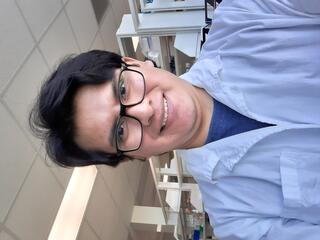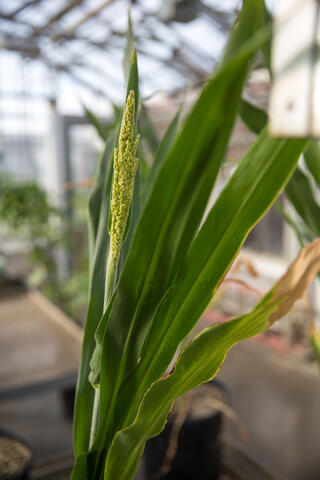
As the Keegstra Bioenergy Research Fellow exploring the sorghum microbiome, Marco Mechan-Llontop is working with Ashley Shade at Michigan State University and John Mullet at Texas A&M to explore plant-microbe interactions in the sorghum phyllosphere (aboveground plant material) and rhizosphere (belowground). Marco started his position in February. Connect with him at mechanll@msu.edu.

Tell us a little about your background. What and where did you study before joining GLBRC?
I'm from the north coast of Peru, where I got my bachelor's degree in biology. As an undergrad, I studied the Pseudomonas genus on the tomato phyllosphere. After graduation, I had the opportunity to come to the U.S. for a short internship, and I worked with Boris Vinatzer at Virginia Tech. And after that experience, I was admitted to the Translational Plant Science Program, an interdisciplinary graduate program at Virginia Tech. I did rotations in different labs during my first year as a Ph.D. student, and then I joined Boris Vinatzer’s lab, where I got my Ph.D. in plant pathology.
What led you to this Keegstra fellowship?
During my Ph.D. research, I followed Ashley Shade's work very closely, then I heard about this position through the GLBRC. I got very interested because the topic was on studying the phyllosphere microbiome of bioenergy sorghum and understanding the plant-microbe interaction at the community level. That is kind of a new system for me. I have been very interested in studying bacteria with unique characteristics and translate this knowledge to help crops used in bioenergy research.
Which research groups are you working in?
I’m working with Ashley Shade and John Mullet. As I said, I've been following Ashley's research on microbiomes and plant resilience for a long time when I was a Ph.D. student. And John works on plant genetics and genomics, especially in sorghum. This gives me the chance to work with both the microbes and the genetics of the plant and understand how these genetics and the microbiome composition are related.
What research questions will you be working on?
We know that plants are associated with a high diversity of microorganisms called the microbiome. And we know that these microbiomes influence plant health and plant traits, for example, resistance and productivity. During development, sorghum accumulates high levels of epicuticular wax on the stems, and we know that this wax accumulations support tolerance to water limitation. The sorghum also grows aerial roots, and these aerial roots are covered by mucilage. But we don't know the role of this mucilage yet.

The Shade lab had studied the microbial communities in plant resilience, and the Mullet lab studied the genetics and genomics of sorghum, especially the genetics of this wax accumulation. At the GLBRC, I’ll be combining those different areas. So I'm going to study the interplay between the phyllosphere microbiome, the epicuticular wax, the aerial root mucilage, and sorghum resilience to water and nitrogen limitation.
There are specific bacteria associated with this type of mucilage in maize, so it's hypothesized that sorghum and different cereals have the same bacteria that may help the plants by fixing nitrogen from the environment. That's my hypothesis—I think that the epicuticular wax and the mucilage are suitable environments for the specific bacteria that support sorghum resilience to stress.
This program is about bridging different areas of research within the GLBRC. Has any work been done before to really bring together the sorghum work and some of the microbiome work?
Sorghum is an emerging crop of interest for microbiome work. Some work from the Coleman-Derr lab at the USDA has focused on the rhizosphere microbiome to study how the rhizosphere microbiome improves drought tolerance, but we don't know much about the phyllosphere microbiome. There is also some sorghum microbiome work ongoing at another Bioenergy Research Center, CABBI. We don't know much about either the chemistry or the microbiome of the wax or mucilage in sorghum. I want to find the right collaborators here to fill some gaps in our knowledge in that—I really like how people collaborate in the GLBRC. I hope to have the chance to work with different research teams. If I find some specific microorganisms that help the plant perform better under water or nitrogen limitations, hopefully, we can use those microorganisms, maybe in synthetic communities to increase biomass.
What do you like to do outside the lab?
I like hiking. I play the guitar. I love science fiction movies, and I like reading books. Right now, I'm reading motivational books, like how to work under these difficult times and how to be productive while working at home. I’m reading a book Ashley suggested to me called Radical Candor. It’s about how to lead a team and improve relationships at work.
What type of work do you hope to do in the future?
I'm interested in an academic career. I want to lead my own independent research in a research institution, such as at a university or research institution like the GLBRC. I want to stay in bioenergy research because I think it's a very important area that allows us to contribute to a global issue.
The Keegstra Bioenergy Research Fellowships are two-year postdoctoral appointments in integrative bioenergy sciences that promote interdisciplinary research in lignocellulosic bioenergy and bioproducts. Learn more